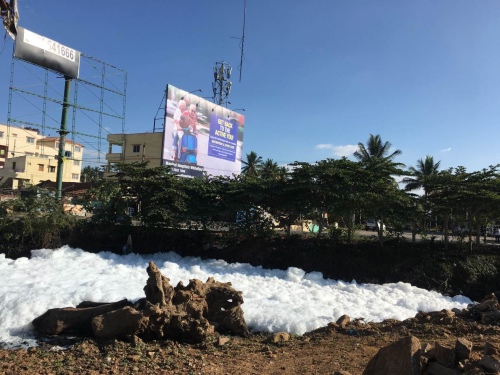Parched Cape Town, in South Africa, has managed to push back its “Day Zero” – an estimate of when taps in the city could run dry – to 2019 after successful water-saving efforts.
But in India, “Day Zero” has come and gone for residents in many parts of the country, where taps failed long ago and people have turned instead to digging wells or buying water.

A view of a heavily polluted lake in the southern Indian city of Bengaluru, which is on the verge of a water crisis as groundwater is depleted at a rapid pace, 24th December, 2017. PICTURE: Rina Chandran/Thomson Reuters Foundation
An expanding population, growing demand for water from agriculture and industry, and poor management of water supplies have sent India’s groundwater to ever lower levels.
That reality, combined with rising temperatures, threatens worsening scarcity, experts say.
Nearly 163 million people among India’s population of 1.3 billion – or more than one in 10 – lack access to clean water close to their home, according to a 2018 WaterAid report.
That is the most of any country in the world, according to the UK-based charity, which aims to provide clean water and better hygeiene to people without them.
Disputes with neighbours over the sharing of water from rivers that cross national boundaries also means tensions are rising as water shortages grow, said Michael Kugelman, a deputy director and South Asia expert at the Wilson Center, a policy think tank in Washington, DC.
“Countries that get along the least are forced to share and cooperate over water resources, and many major rivers originate in, or pass through, politically contested and tense areas,” he told the Thomson Reuters Foundation.
“So you have population growth, intensifying climate-change impacts, poor water management and geopolitical tensions. It’s a perfect storm for greater water insecurity,” he said.
India is entangled in water disputes with its eastern and western neighbours – Bangladesh and Pakistan – which accuse it of monopolising water flows moving downstream toward them.
To the north and northeast, however, India fears a loss of water to upstream China, which plans a series of dams over the Tsangpo river, called the Brahmaputra as it flows into eastern India.
While India’s trans-boundary rivers are governed by treaties on how water should be shared, disputes are increasing as water shortages stoke tensions.
Apart from in Bhutan and Nepal, South Asia’s per capita water availability is already below the world average. The region could face widespread water scarcity – less than 1,000 cubic metres available per person – by 2025, Kugelman said.
Almost 600 million people in India are at high risk of being unable to continue relying on surface water – including in the country’s northwest and south, where much of the country’s staple wheat and rice are grown, according to the World Resources Institute.
Water supply in India may fall 50 per cent below demand by 2030, the Asian Development Bank has forecast.
“Large parts of India have already been living with ‘Day Zero’ for a while now,” said Mridula Ramesh, author of an upcoming book on climate change.
“Much of it is because of bad management. Most cities lose between a third and a fifth of their water from pilferage or leakage through antiquated pipes, and we don’t treat and reuse wastewater enough,” she said.
Bengaluru, Karachi and Kabul are among the 10 cities in the world that are “on the verge of an imminent water crisis”, according to a report last month by the Centre for Science and Environment, a research and advocacy group based in New Delhi.
Bengaluru, once known as the “city of lakes”, now relies heavily on groundwater, which is not being naturally replenished and cannot sustain the growing population, said Sushmita Sengupta at CSE.
“‘Day Zeros’ are inevitable unless cities push for judicious use of water – including rainwater harvesting and reuse of waste water, as well as more efficient irrigation, and regulation of tubewells,” she said.
India is one of the largest consumers of groundwater in the world, with worsening shortages attributed in part to subsidies that help farmers run electric irrigation pumps cheaply for longer than needed, and to a lack of limits on extracting water or digging wells.
Some states are taking steps to manage water better. Karnataka and Maharashtra require industries to use treated urban wastewater, with Gujarat and other states also planning similar measures.
But regulating water use is a politically sensitive issue – one few policymakers are keen to address, Mr Kugelman said. That’s the case even as thousands of farmers migratw out of parched rural areas or commit suicide as their crops wilt, he said. .
Water scarcity is expected to force 50 to 70 million people in India, Bangladesh, Nepal and China from their homes by 2050, according to research by the Strategic Foresight Group in Mumbai.
“With greater migration to the cities, there will be increased social disruptions and greater stress on water resources in urban areas,” Mr Kugelman predicted.
“These will, in turn, increase tensions between states and countries over water. Even treaties can’t help then.”





